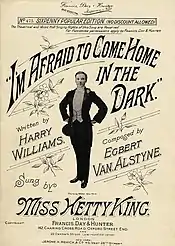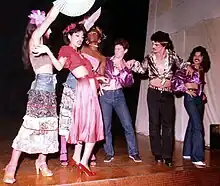Drag king
Drag kings have historically been mostly female performance artists who dress in masculine drag and personify male gender stereotypes as part of an individual or group routine.[1] As documented in the 2003 Journal of Homosexuality, in more recent years the world of drag kings has broadened to include performers of all gender expressions.[2] A typical drag show may incorporate dancing, acting, stand-up comedy and singing, either live or lip-synching to pre-recorded tracks.[3] Drag kings often perform as exaggeratedly macho male characters,[4] portray characters such as construction workers and rappers or they will impersonate male celebrities like Elvis Presley, Michael Jackson and Tim McGraw.[5] Drag kings may also perform as personas that do not clearly align with the gender binary. Drag personas that combine both stereotypically masculine and feminine traits are common in modern drag king shows.[6]

| Cross-dressing |
|---|
| Part of a series on |
| LGBT topics |
|---|
|
|
In the late 1800s and early 1900s, several drag kings became British music hall stars and British pantomime has preserved the tradition of women performing in male roles. Starting in the mid-1990s, drag kings started to gain some of the fame and attention that drag queens have known.[7][8]
History and terminology


While the term drag king was first cited in print in 1972,[9] there is a longer history of female performers dressing in male attire. In China, the practice of "female men [characters]" (kunsheng; see also sheng roles), where women portrayed men in stage performances, were first documented during the middle Tang dynasty (617–908 CE). This continued through to the early Qing dynasty, when the Qianlong Emperor banned actresses from performing in 1722. It was revived in the late 19th and 20th centuries as the ban on actresses was loosened.[10]
In theatre and opera, there was a tradition of breeches roles and en travesti.[11] Actress and playwright Susanna Centlivre appeared in breeches roles around 1700.[12] The first popular male impersonator in U.S. theatre was Annie Hindle, who started performing in New York in 1867.[13] In 1886, she married her dresser, Annie Ryan.[14]
British music hall performer Vesta Tilley was active in the late 19th and early 20th centuries as a male impersonator.[15] Other male impersonators on the British stage were Ella Shields and Hetty King.[16] Blues singer Gladys Bentley performed in male attire in New York, Los Angeles and San Francisco from the 1920s through 1940s.[17]
Stormé DeLarverie performed in male drag as the MC, and sole female performer, of the drag troupe the Jewel Box Revue in the 1950s and 1960s. She is featured in the documentary Storme: The Lady of the Jewel Box.[18] While the Stonewall riots of June 1969, were a series of spontaneous uprisings by many people, DeLarverie—who was the first to fight back against the police brutality—is believed to have provided the spark that ignited the riot.[19][20][21]
Drag king culture in Australia flourished in lesbian bars from the 1990s and 2000s, but began to fade in the 2010s.[22]
The term drag king is sometimes used in a broader sense, to include female-bodied people who dress in traditionally masculine clothing for other reasons. This usage includes women temporarily attempting to pass as men and women who wish to present themselves in a masculine gender role without identifying as a man. Diane Torr began leading Drag King Workshops in 1989 that offer women a lesson in passing as men.[23][24] Torr was featured in the 2002 film on drag kings Venus Boyz.[25]
Drag kings have historically been more marginalized by pop culture than drag queens, who began playing a larger role in mainstream pop culture from the late 20th Century onwards.[26] Drag kings have also historically been marginalized in academic LGBT studies.[27] Recently, drag kings have started to play a slightly more visible role in the LGBT community. Sleek Magazine described this renaissance of drag king culture in a 2019 article titled "What's behind the drag king revolution?"[28]
The British drag king collective 'Pecs', a troupe made up entirely of women and non-binary people, was founded in 2013 and went on to perform at Soho Theatre and The Glory.[29] In 2016, director Nicole Miyahara produced The Making of a King, a documentary film chronicling the lives of contemporary drag kings in Los Angeles.[30] The first drag king to appear in a television show was New Zealand artist and comedian Hugo Grrrl who won the inaugural season of the New Zealand reality competition House of Drag in 2018.[31] In 2019, American artist Landon Cider was the first drag king and cisgender woman to appear on a televised US drag competition when he won the third season of The Boulet Brothers' Dragula.[32] In June 2022, three drag kings made a guest appearance in series one of Drag Race France,[33] the first time the Drag Race franchise included drag kings.
Drag community

A British lesbian cabaret organization called Lesburlesque made it part of their mission to promote drag kings on the wider British cabaret circuit. Their founder Pixie Truffle gave an interview to the Guardian newspaper in the United Kingdom on her desire for drag kings to close the gap with queens and with male stand-up comedians.[34]
Similar to some drag queens who prefer to be seen as actors—like Justin Bond and Lypsinka—some drag kings prefer not to be pigeon-holed by the drag king label. "I think when people assume that somebody is queer, or different, or trans, they always want to put something before their name," said Murray Hill in an interview. "And that is what drag king has been. Why can not you just call me a comedian like Jerry Seinfeld is called a comedian?"[35]
In recent years, some drag king performers have adopted other terms to describe their own performance styles, particularly if they deviate from the more traditional forms of "kinging". Common names including "gender blurring" acknowledge the merging of both male and female traits in the performances. Vancouver performer Rose Butch adopted the ambiguous label "drag thing".[36] Long-time performer Flare called the stage of drag king styles that emerged in Toronto's scene in the mid-2010s as "unicorn drag".[36]
Tools of gender illusion
Face: One method drag kings use to modify their facial features is burning a wine cork and smudging it along the jaw to create the illusion of a beard or stubble.[37] Kings may aim to deepen the colour of their eyebrows or create a fuller look with dark eyeliner or other makeup. Similarly some methods call for layering liquid eyeliner over the cork ash, or dark makeup, base.[37] When trying to achieve a realistic look, drag kings may add crepe hair over the makeup using glue, thus completing the illusion of a full beard.[38]
Look: Drag kings also make use of items such as socks and silicone prosthetics when packing,[39][40] creating the illusion of a male appendage between the legs.[41][38]
Stage Presence and Performance: An important part of gender illusion, this refers to the way a drag performer utilizes body language and takes up space on stage. Some kings will incorporate more aggressive choreography into their routines to emulate or expand on stereotypical masculine characteristics.[37] Accessories, rhinestones and elaborate costumes contribute to a drag king's performance.[42]
Breast binding
Body shaping apparel, most commonly binders, kinesiology tape, and sports bras, are used to create the look of a flat chest.[38] For hiding one's breasts some use a method involving cutting a hole in the crotch of pantyhose for the head and making sleeves out the legs.[43] Some drag kings use silicone chest plates that are pulled over the head to create a muscular, masculine chest shape and cover the breasts.
In entertainment
In film
- Victor/Victoria (1982)
- Connie and Carla (2004)
- Midnight Asia (2022)
In literature
2016–present – Moriarty the Patriot, in which the spy known as James Bond is a drag king persona of Irene Adler, an associate of Sherlock Holmes and the titular Moriarty brothers.[44]
In music
- 2021 – Little Mix presented as drag kings in their music video 'Confetti'[45]
See also
References
- Aronoff, Jen (2005-10-19). "Competitive Drag Kings Strut Stuff: With some spit and polish, women perform in growing world of cross-dressing pageantry". The University of South Carolina Daily Gamecock. Archived from the original on 2007-10-16. Retrieved 2007-07-29.
- Surkan, Kim (2003-04-01). "Drag Kings in the New Wave: Gender Performance and Participation". Journal of Homosexuality. 43 (3–4): 161–186. doi:10.1300/J082v43n03_10. ISSN 0091-8369.
- Dujour, Dick (2006-08-24). "Drag King Contest". San Francisco Bay Times. Retrieved 2007-07-29.
- Beckner, Chrisanne (2005-09-29). "Best of Sacramento - Drag King: Buck Naked". Sacramento News & Review. Retrieved 2007-07-29.
- Long, Cris (2007-07-22). "Bring Out the Kings!: Gage Gatlyn". Out Impact. Archived from the original on 2007-09-29. Retrieved 2007-07-29.
- Surkan, Kim (2003-04-01). "Drag Kings in the New Wave: Gender Performance and Participation". Journal of Homosexuality. 43 (3–4): 161–186. doi:10.1300/J082v43n03_10. ISSN 0091-8369.
- "Gage For Yourself". Watermark Online. 2005-09-22. Archived from the original on 2007-08-24. Retrieved 2007-07-29.
- Caceda, Eden (2015-01-13). "Inside Sydney's drag king culture". Hijacked. Retrieved 2015-01-20.
- Oxford English Dictionary cites Rogers, Bruce (1972), The Queen's Vernacular: A Gay Lexicon, Straight Arrow Books, ISBN 9780879320263
- Hui-ling, Chou (1997). "Striking Their Own Poses: The History of Cross-Dressing on the Chinese Stage". TDR. 41 (2): 130–152. doi:10.2307/1146629. ISSN 1054-2043. JSTOR 1146629.
- Senelick, Laurence (2000), The changing room: sex, drag and theatre, Routledge, ISBN 978-0-415-15986-9
- Pix, Mary; Finberg, Melinda (2001), Eighteenth-century women dramatists, Oxford University Press, p. xviii, ISBN 978-0-19-282729-6
- Ferris, Lesley (1993), Crossing the stage: controversies on cross-dressing, Routledge, p. 90, ISBN 978-0-415-06269-5
- Duggan, Lisa (2000), Sapphic slashers: sex, violence, and American modernity, Duke University Press, p. 147, ISBN 978-0-8223-2617-5
- Maitland, Sarah (1986), Vesta Tilley, Virago, ISBN 0-86068-795-3
- Slide, Anthony (1986), Great pretenders: a history of female and male impersonation in the performing arts, Wallace-Homestead Book Co., ISBN 978-0-87069-474-5
- Gladys Bentley articles, Queer Music Heritage, June 2004, retrieved 2009-11-27
- Klotman, Phyllis Rauch; Cutler, Janet K. (1999), Struggles for representation: African American documentary film and video, Indiana University Press, p. 168, ISBN 978-0-253-21347-1
- "Stonewall Veteran, Drag King Icon Stormé DeLarverie Dies at 93". May 27, 2014. Retrieved October 12, 2017.
- Yardley, William (May 29, 2014) "Storme DeLarverie, Early Leader in the Gay Rights Movement, Dies at 93" in The New York Times.
- Rick, Bragg (1994-06-23), "From a Night of Rage, the Seeds of Liberation", New York Times, retrieved 2009-09-12
- Drysdale, Kerryn. "Strapped, packed and taking the stage: Australia's new drag kings". The Conversation. Retrieved 2020-09-26.
- Halberstam, Judith (2005), "Drag Kings: Masculinity and Performance (1998)", The Subcultures Reader, Routledge, ISBN 978-0-415-34416-6
- Rapi, Nina; Chowdhry, Maya (1998), Acts of passion: sexuality, gender, and performance, Routledge, p. 237, ISBN 978-0-7890-0370-6
- Kramer, Gary (2006), Independent queer cinema: reviews and interviews, Routledge, p. 165, ISBN 978-1-56023-343-5
- Mitchell, Nicole Phelps, Stef (2018-03-08). "Gender Renegades: Drag Kings Are Too Radical for Prime Time". Vogue. Retrieved 2020-09-26.
{{cite web}}: CS1 maint: multiple names: authors list (link) - Koonce, Melissa Suzanne (May 2006). Identity construction and community building in Austin's drag king culture (Thesis thesis).
- "What's behind the drag king revolution?". www.sleek-mag.com. Retrieved 2020-09-26.
- "These Drag Kings Are the Only Royalty We Acknowledge". www.vice.com. Retrieved 2020-09-26.
- Nichols, James Michael (2016-09-28). "You May Know About Drag Queens.. But Do You Know Your Drag King History?". HuffPost. Retrieved 2020-09-26.
- george.fenwick@nzherald.co.nz, George Fenwick George Fenwick is an entertainment writer for The New Zealand Herald (2018-12-20). "House of Drag winner Hugo Grrrl on his 'life-changing' win". NZ Herald. ISSN 1170-0777. Retrieved 2020-03-11.
- "'Dragula' Season 3 Winner: Landon Cider Takes The Crown". Billboard. 2019-10-29. Retrieved 2020-07-15.
- "Queen Pour Cent". IMDb. IMDb.com Inc. Retrieved 2 June 2023.
- "The Guardian Interview with Pixie Truffle about the rise of Drag Kinging". The Guardian. 26 August 2012. Retrieved 26 August 2012.
- Brune, A. M. (2016-03-28). "Murray Hill: 'I'm more than a drag king. Why can't you just call me a comedian?'". The Guardian. ISSN 0261-3077. Retrieved 2020-03-07.
- Friend, David (June 20, 2017). "Kings of the night: New era of gender dynamics offers drag kings a brighter spotlight". CTV News/The Canadian Press. Retrieved June 26, 2017.
- Stortz, Sarah. "Kings of Drag: The secrets behind the fake beards". The Daily Iowan. Retrieved 2020-07-28.
- "Watch: BuzzFeed Video - Women Transform Into Drag Kings". BuzzFeed. Retrieved 2020-07-28.
- Stevens, Phillips (2014-11-17), "Culture and sexuality", The International Encyclopedia of Human Sexuality, Oxford, UK: John Wiley & Sons, Ltd, pp. 1–8, doi:10.1002/9781118896877.wbiehs110, ISBN 978-1-118-89687-7
- Whelehan, Patricia; Bolin, Anne, eds. (2015). The international encyclopedia of human sexuality. ISBN 978-1-78684-299-2. OCLC 985403957.
- Shapiro, Eve (2007). "Drag Kinging and the Transformation of Gender Identities". Gender and Society. 21 (2): 250–271. doi:10.1177/0891243206294509. ISSN 0891-2432. JSTOR 27640961. S2CID 145789681.
- Mitchell, Nicole Phelps, Stef (2018-03-08). "Gender Renegades: Drag Kings Are Too Radical for Prime Time". Vogue. Retrieved 2020-07-28.
{{cite web}}: CS1 maint: multiple names: authors list (link) - "How to: be a drag King". Lesbilicious. April 25, 2008. Archived from the original on May 24, 2009. Retrieved April 16, 2021.
- Collins, Hannah (April 27, 2021). "Moriarty the Patrot Takes a Positive Stance on Trans Rights". CBR. Retrieved July 1, 2021.
- Kaufman, Gil (April 30, 2021). "Little Mix and Saweetie Flip the Gender Script in 'Confetti' emix Video". Billboard. Retrieved July 1, 2021.
Further reading
- Halberstam, Judith "Jack"; Volcano, Del LaGrace (1999). The Drag King Book. London: Serpent's Tail. ISBN 978-1852426071.
External links
- Drag king resources
- 'How to be a drag king' by London king Lenna Cumberbatch Archived 2009-05-24 at the Wayback Machine
- Anderson Toone's drag king time-line with photos and events
- Art of Drag Kinging by Dante DiFranco
- Drag Kingdom, Germany king networking and events site
- Drag Kings at Curlie
- San Francisco Drag King Contest, the oldest (and possibly largest) drag king event
- UK and Irish Drag Kings, Drag King Photography
- Technodyke's drag king archived articles and interviews
- Girls will be boys Archived 2016-09-11 at the Wayback Machine: an article on the otokoyaku, or male role players, of the all-female Japanese Takarazuka Revue
- Radio Documentary, The Drag King Show, produced by JD Doyle for Queer Music Heritage including interviews with Anderson Toone and Leigh Crow.